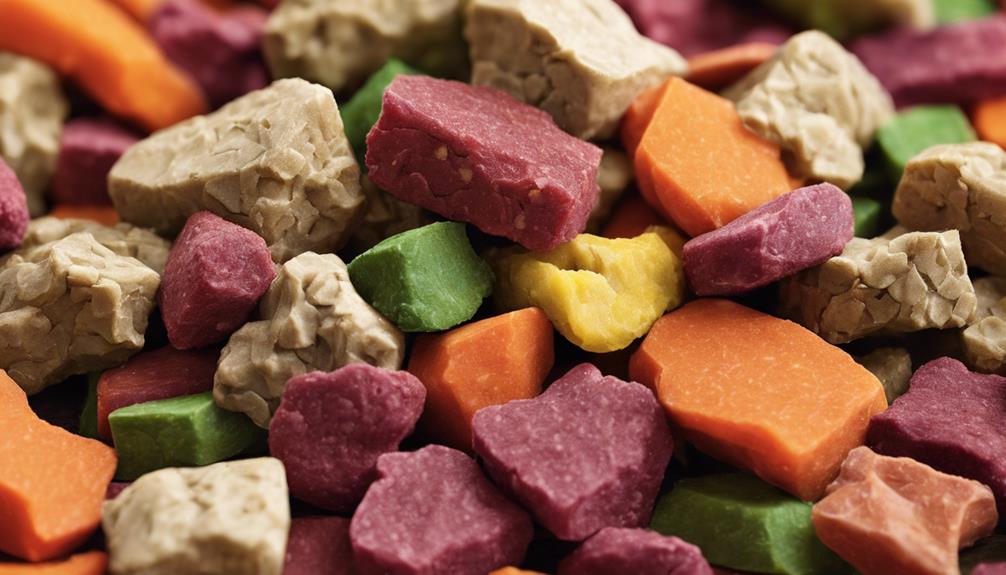Chrysanthemums are dangerous for dogs. They contain harmful substances that can make them sick. If a dog ingests chrysanthemums, they may experience vomiting, diarrhea, or trembling. It is crucial to promptly take them to the veterinarian if poisoning is suspected. Treatment can be costly, ranging from hundreds to thousands of dollars. Symptoms of chrysanthemum poisoning include vomiting, trembling, and difficulty breathing. Immediate veterinary care is essential for proper treatment. To avoid issues, keep chrysanthemums out of reach of pets. Supervision and knowledge of symptoms are important. Take swift action if your dog consumes chrysanthemums for their health and well-being.
Key Takeaways
- Chrysanthemums contain pyrethrins and sesquiterpene lactones toxic to dogs.
- Symptoms of poisoning include vomiting, diarrhea, tremors, and difficulty breathing.
- Urgent veterinary care is crucial if chrysanthemum poisoning is suspected.
- Treatment involves toxin elimination, symptom relief, and can cost $200-$3,000.
- Prevent exposure by keeping chrysanthemums out of reach and being cautious with topical flea treatments.
Chrysanthemum Toxicity in Dogs
Chrysanthemum toxicity in dogs can lead to severe symptoms requiring urgent veterinary intervention. Chrysanthemums contain substances like pyrethrins and sesquiterpene lactones, which are harmful to dogs when ingested.
If a dog consumes parts of the chrysanthemum plant, it can result in symptoms such as vomiting, diarrhea, and tremors. It's important to seek veterinary care immediately if poisoning is suspected.
Treatment for chrysanthemum poisoning in dogs may involve eliminating the toxins from the body and administering medications to alleviate the symptoms. The cost of treating chrysanthemum poisoning in dogs can vary, ranging from $200 to $3,000, depending on the severity of the case.
Symptoms of Chrysanthemum Poisoning

After discussing the dangers of chrysanthemum toxicity in dogs, it's important to recognize the various symptoms that can indicate poisoning in our furry companions. When our dogs ingest chrysanthemums, they may experience vomiting, diarrhea, lethargy, tremors, and difficulty breathing. Additionally, poisoning from chrysanthemums can manifest as drooling, shaking, agitation, incoordination, and skin rashes. Neurological signs like seizures, muscle tremors, and hypersalivation can also occur. Monitoring our dogs for these symptoms is vital as chrysanthemum poisoning can lead to gastrointestinal upset, dermatitis, and central nervous system effects. If your dog shows any signs of chrysanthemum poisoning, it is essential to seek prompt veterinary care to guarantee proper treatment and aid in their recovery.
| Symptoms | Description |
|---|---|
| Vomiting | Expelling stomach contents forcefully |
| Diarrhea | Loose, watery stools |
| Lethargy | Lack of energy or enthusiasm |
| Tremors | Involuntary shaking of the body |
| Seizures | Abnormal electrical activity in the brain leading to convulsions |
Treatment for Chrysanthemum Toxicity

Inducing vomiting and administering activated charcoal are key steps in treating chrysanthemum toxicity in dogs. These actions help eliminate the toxin from the body, preventing further harm.
Detoxification is essential, involving procedures like gastric lavage and IV fluid therapy to support the dog's recovery process. In severe cases where seizures occur due to chrysanthemum poisoning, medications such as phenobarbital may be prescribed to manage these symptoms effectively.
The average cost of treatment for chrysanthemum toxicity in dogs varies from $300 to $950, depending on the severity of the condition and the required interventions. With proper care and monitoring, most dogs show significant improvement within 24 hours after receiving treatment.
It's important to act promptly and follow the veterinarian's recommendations to guarantee the best outcome for your furry companion. Remember, quick intervention and appropriate medical attention are essential in helping your dog recover from chrysanthemum toxicity.
Preventing Chrysanthemum Exposure in Dogs

To safeguard our canine companions from potential harm, it's vital to take proactive measures in preventing exposure to chrysanthemums. These flowers can lead to gastrointestinal upset, hypersalivation, dermatitis, and even neurological symptoms like tremors and seizures in dogs. It's essential to keep chrysanthemum plants out of reach, whether in your garden or inside your home.
If you're using topical flea treatments containing pyrethrins, make sure they're only applied to dogs, as they can be lethal to cats. Remember, cats are also highly susceptible to chrysanthemum toxicity and may experience severe neurological symptoms if exposed. By being vigilant and mindful of where you place chrysanthemums and products containing pyrethrum, you can reduce the risk of harm to your pets.
If you suspect your pet has ingested or come into contact with chrysanthemums, seek immediate veterinary care to address any symptoms promptly and prevent complications.
Managing Chrysanthemum Toxicity Risks

Taking proactive steps to minimize chrysanthemum toxicity risks in dogs is essential for guaranteeing their well-being. To manage these risks responsibly, consider the following:
- Supervise: Keep a close eye on your pets when they're around chrysanthemum plants to prevent ingestion.
- Secure: Ensure chrysanthemums are out of reach of curious paws by placing them in elevated areas or fenced-off sections.
- Educate: Learn about the symptoms of chrysanthemum toxicity in dogs, such as vomiting, diarrhea, and neurological issues.
- Act: If you suspect your dog has ingested chrysanthemums, seek immediate veterinary care to address any toxicity risks.
- Prevent: Emphasize responsible pet ownership by educating yourself and others about the dangers of chrysanthemums and taking proactive measures to prevent incidents.
Frequently Asked Questions
What Are the Dangers of Chrysanthemum?
Chrysanthemums pose risks to dogs due to toxins like pyrethrins, causing issues such as CNS overactivity, low blood pressure, and respiratory failure. Symptoms of chrysanthemum poisoning include vomiting, seizures, and coma.
Treatment for this poisoning can cost between $300 to $950.
Quick veterinary attention is vital when a dog ingests chrysanthemums to prevent severe health issues.
What Are the Symptoms of Chrysanthemums Poisoning?
Symptoms of chrysanthemum poisoning in dogs include vomiting, diarrhea, lethargy, and tremors. Chrysanthemum poisoning can also cause difficulty breathing, hypersalivation, and incoordination in dogs. Skin rashes, agitation, and neurological signs like seizures may be present in dogs poisoned by chrysanthemums.
Immediate veterinary attention is vital if a dog shows signs of chrysanthemum poisoning. Monitoring for additional symptoms like drooling and shaking is important in cases of chrysanthemum toxicity in dogs.
What Is the Toxin in Chrysanthemum?
The toxin in chrysanthemums is pyrethrins and sesquiterpene lactones. Pyrethrins impact sodium channels, causing CNS overactivity and respiratory failure.
Sesquiterpene lactones and pyrethrins can lead to low blood pressure and coma.
These toxins are what cause poisoning in dogs that ingest chrysanthemums.
Understanding these toxins is essential for identifying and managing chrysanthemum toxicity in dogs.
What Happens if a Dog Eats Mums?
If a dog eats mums, it can lead to symptoms like vomiting, diarrhea, drooling, and even neurological effects such as tremors and seizures.
The toxins in mums, like pyrethrins, can affect a dog's nervous system, causing incoordination and agitation.
Immediate veterinary care is essential to prevent severe toxicity.
:Are Chrysanthemums and Geraniums Equally Toxic to Dogs, and What Are the Dangers?
Chrysanthemums and geraniums can be equally toxic to dogs. Ingesting these plants can lead to symptoms such as vomiting, diarrhea, and even more severe issues like kidney failure. It’s vital to keep these plants out of your dog’s reach to prevent geranium toxicity in dogs.
Conclusion
To sum up, while chrysanthemums may add beauty to your garden, they can pose a serious threat to our furry friends. It's important to be aware of the dangers they can bring and take steps to keep our dogs safe.
Remember, what may be lovely to look at can be harmful if ingested. So, keep a watchful eye on your pets and avoid potential risks whenever possible. Prevention is key in ensuring their well-being.










